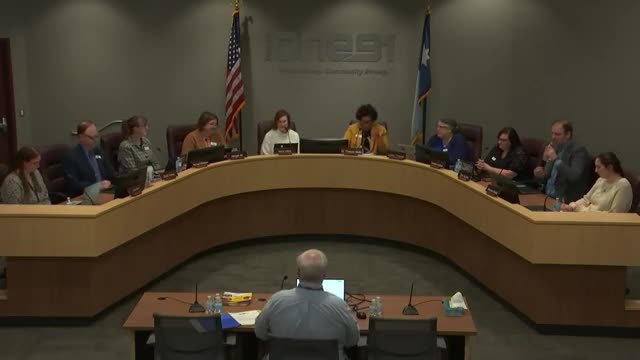ISD 191 presents FY25–26 educational equity plan; multilingual instruction and 'Grow Your Own' program highlighted
April 26, 2025 | BURNSVILLE PUBLIC SCHOOL DISTRICT, School Boards, Minnesota
This article was created by AI summarizing key points discussed. AI makes mistakes, so for full details and context, please refer to the video of the full meeting. Please report any errors so we can fix them. Report an error »

The Independent School District 191 Board of Education on April 24 received the district's FY25–26 Educational Equity Plan and examples of classroom practice for multilingual learners.
Isis Buchanan, director of educational equity, told the board the plan centers on ensuring "access and fostering academic excellence for all learners" and aligns with district Policy 105. Buchanan said roughly 72.5% of District 191 students identify as Black, Indigenous or people of color, about 26.5% are English learners and the student body represents 106 languages; the most common birth countries after the United States are Ecuador, Honduras, El Salvador, Mexico and Venezuela. Buchanan also said roughly 57% of students qualify for free or reduced-price lunch and noted a demographic gap between students and staff: about 80% of district staff identify as white while about 20% identify as BIPOC.
Buchanan described the plan's main strategies: strengthening site-based equity teams, embedding professional development aligned to a culturally proficient school systems (CPSS) framework, implementing gender-inclusive and non‑exclusionary discipline practices, and expanding recruitment and retention initiatives including the district's "Grow Your Own" program. She said the Grow Your Own program currently has candidates at several partner institutions and can add about six additional participants.
Kiefer Anderson, a multilingual teacher at Gideon Pond Elementary, described co‑teaching models used in elementary classrooms — parallel teaching, station teaching, team teaching and "one teach, one assist" — and shared short classroom videos showing multilingual students participating in expository nonfiction lessons and math instruction. Anderson said the school uses "push-in" co-teaching to keep students in grade-level classrooms and to scaffold language while maintaining access to grade-level curriculum. He described a focus program at Gideon Pond with 15 students, seven of whom are multilingual; Anderson said co-teaching in that setting supports both language development and special-education goals.
Board members asked about metrics and family engagement. Buchanan said the district will use equimetric and organometric surveys, along with annual family, student and staff surveys, site visit observations and evidence of professional development participation, to track progress. Director Ault asked how the district recruits diverse parent participation for advisory groups; Buchanan described outreach through liaisons, a sign-up form on the district website and targeted language‑specific parent meetings.
Buchanan and Anderson emphasized the district's goal of creating inclusive classrooms where multilingual students are recognized as instructional assets and where staff across general education, special education and multilingual teams collaborate.
The presentation closed with an invitation to monitor implementation through the district's regular reporting channels and site visits.
Isis Buchanan, director of educational equity, told the board the plan centers on ensuring "access and fostering academic excellence for all learners" and aligns with district Policy 105. Buchanan said roughly 72.5% of District 191 students identify as Black, Indigenous or people of color, about 26.5% are English learners and the student body represents 106 languages; the most common birth countries after the United States are Ecuador, Honduras, El Salvador, Mexico and Venezuela. Buchanan also said roughly 57% of students qualify for free or reduced-price lunch and noted a demographic gap between students and staff: about 80% of district staff identify as white while about 20% identify as BIPOC.
Buchanan described the plan's main strategies: strengthening site-based equity teams, embedding professional development aligned to a culturally proficient school systems (CPSS) framework, implementing gender-inclusive and non‑exclusionary discipline practices, and expanding recruitment and retention initiatives including the district's "Grow Your Own" program. She said the Grow Your Own program currently has candidates at several partner institutions and can add about six additional participants.
Kiefer Anderson, a multilingual teacher at Gideon Pond Elementary, described co‑teaching models used in elementary classrooms — parallel teaching, station teaching, team teaching and "one teach, one assist" — and shared short classroom videos showing multilingual students participating in expository nonfiction lessons and math instruction. Anderson said the school uses "push-in" co-teaching to keep students in grade-level classrooms and to scaffold language while maintaining access to grade-level curriculum. He described a focus program at Gideon Pond with 15 students, seven of whom are multilingual; Anderson said co-teaching in that setting supports both language development and special-education goals.
Board members asked about metrics and family engagement. Buchanan said the district will use equimetric and organometric surveys, along with annual family, student and staff surveys, site visit observations and evidence of professional development participation, to track progress. Director Ault asked how the district recruits diverse parent participation for advisory groups; Buchanan described outreach through liaisons, a sign-up form on the district website and targeted language‑specific parent meetings.
Buchanan and Anderson emphasized the district's goal of creating inclusive classrooms where multilingual students are recognized as instructional assets and where staff across general education, special education and multilingual teams collaborate.
The presentation closed with an invitation to monitor implementation through the district's regular reporting channels and site visits.
View full meeting
This article is based on a recent meeting—watch the full video and explore the complete transcript for deeper insights into the discussion.
View full meeting
